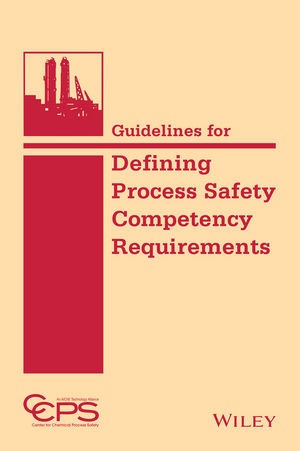Read more
This Guideline presents the framework of process safety knowledge and expertise versus the desired competency level in a "super-matrix" format, vertically and diagonally. The matrix references for potential remedies/required training may be tailored to a company's internally developed training, reference externally available training, or some combination of the two.
Chapters include: Identify Process Safety Roles & Competency Needs; Process Safety Competency Matrix; Individual and Corporate Process Safety Competencies; Conduct Assessments vs. Needs; Develop Gap Closure Plans; and Sustaining Competencies.
List of contents
Dedication xi
List of Tables xvii
Files on the Web Accompanying This Book xix
Acronyms and Abbreviations xxi
Glossary xxiii
Acknowledgements xxv
Preface xxvii
Executive Summary xxix
ORGANIZATION OF THIS BOOK xxix
INTRODUCTION 1
1.1 Why process safety competency? 1
1.2 Purpose 2
1.3 Audience 3
1.4 How to Use This Process 4
1.5 Risk Based Process Safety Elements 5
1.6 CCPS Vision 20/20 10
1.7 References 11
2. IDENTIFY PROCESS SAFETY ROLES & COMPETENCY NEEDS 13
2.1 List of generic job roles 13
2.2 List of proficiency levels 18
2.3 List of process safety knowledge/skills 21
3. PROCESS SAFETY COMPETENCY MATRIX 23
3.1 What is the matrix? 23
3.2 How to customize the matrix 25
3.3 Uses of the Matrix 31
3.4 References 38
4. INDIVIDUAL AND ORGANIZATIONAL PROCESS SAFETY COMPETENCIES 39
4.1 Develop organization specific competencies 39
4.2 Assure compliance with regulations 41
4.3 Example Templates and Checklists 44
4.4 References 46
5. ASSESS COMPETENCIES VS. NEEDS 49
5.1 Assessing existing competencies 49
5.2 Training for assessors 50
5.3 Identify Gaps between current status and needs 51
6. DEVELOP GAP CLOSURE PLAN 53
6.1 Methods for closing the gaps 54
6.2 Supporting materials 55
6.3 Pre-requisites before progressing to the next level 57
6.4 EXAMPLE of MANAGing GAP CLOSURE 57
7. SUSTAINING COMPETENCIES 59
7.1 Strategies for Sustaining Competencies 59
7.2 Review and Update Competency Needs 61
7.3 Organizational Process Safety Culture 62
7.4 References 62
APPENDIX 1: EXAMPLE COMPETENCIES FOR AUDITING 63
APPENDIX 2: PHM COORDINATOR & HA FACILITATOR QUALIFICATIONS 65
A2.1 Purpose 65
A2.2 Assumptions 65
A2.3 Full Time Equivalent (FTE) Resource Alignment 68
A2.4 Expertise and Experience 69
A2.5 EHS and PHM Alignment 69
A2.6 Overview of Duties and Responsibilities 72
A2.7 Competency-Based Knowledge (Training) Road Map for Qualification 73
APPENDIX 3: HAZOP FACILITATOR 75
APPENDIX 4: SHOWING GAP CLOSURE PROGRESS
Index 8
About the author
Since 1985, the
Center for Chemical Process Safety (CCPS) has been the global leader in developing and disseminating information on process safety management and technology. CCPS, an industry technology alliance of the American Institute of Chemical Engineers (AIChE), has published over 100 books in its process safety guidelines and process safety concepts series, and over 100 training modules through its Safety in Chemical Engineering Education (SACHE) series.
Summary
This Guideline presents the framework of process safety knowledge and expertise versus the desired competency level in a super-matrix format, vertically and diagonally.

